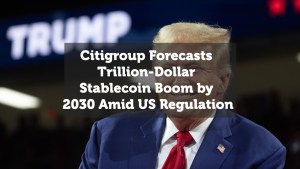
Tether Plans U.S. Payments Expansion with Stablecoin Point-of-Sale System
Tether, the company behind the widely-used USDT stablecoin, is no longer content with just powering crypto trades. Now, it’s setting its sights on the U.S. payments market, exploring a stablecoin-enabled point-of-sale system aimed at competing with major players like Square. This marks a bold move to transform stablecoins from trading tools into everyday currency, offering consumers a blockchain-powered alternative to traditional checking accounts.
As stablecoins gain ground globally and legislation begins to catch up, Tether is betting big on mainstream adoption. Here’s what the company has in store—and what it means for the future of finance.
Tether’s Strategy: Go Consumer First
While most competitors focus on the institutional side of payments, Tether is taking a more consumer-centric approach to its U.S. entry. The idea? To make USDT a viable payment method at stores, restaurants, and online checkout portals, just like Apple Pay or a debit card.
Key Elements of the Strategy:
- Direct-to-Consumer Focus: Tether isn’t just targeting financial institutions. It wants everyday users and small businesses to use USDT for everything from coffee to car payments.
- Stablecoin-as-a-Checking-Account: By positioning USDT as a reliable, dollar-pegged digital cash alternative, Tether hopes to replace traditional bank accounts for certain users—especially those looking for faster, cheaper, and more global payment options.
Fueling Growth with Deep Pockets
Tether isn’t short on resources. As of early 2025, the company reportedly holds around $20 billion in undistributed profits, giving it massive runway to invest in this new venture.
This capital could fund:
- Development of the point-of-sale infrastructure
- Merchant onboarding programs
- Incentives for early adoption
- Strategic marketing and education campaigns
If executed well, this could fast-track the launch and scale of Tether’s payment solution, especially in underserved or high-fee merchant categories.
The Regulatory Elephant in the Room
Despite the optimism, Tether’s move into U.S. retail finance won’t be without challenges—regulatory clarity is still lacking for stablecoins.
Concerns on the Table:
- Federal Oversight: U.S. lawmakers are still debating how to regulate stablecoins—whether through the Federal Reserve, the SEC, or a new digital currency framework altogether.
- Licensing Hurdles: For Tether to launch a payments network legally, it may need licenses in every U.S. state or a federal-level authorization if stablecoin legislation like the GENIUS Act passes.
- Public Scrutiny: Tether’s past controversies over reserve transparency could slow down approval or attract stricter compliance expectations.
The company has signaled that it won’t fully move forward until the legal framework is better defined, but it’s clearly preparing to move quickly when the time is right.
Adoption Isn’t Guaranteed
Tether’s biggest hurdle might not be regulatory—it could be consumer behavior.
In the U.S., traditional bank-held dollars dominate. Most Americans are used to debit cards, credit cards, and mobile wallets linked to their bank accounts. Convincing people to switch to a stablecoin, even if it’s pegged to the dollar, could be a tough sell.
Key Adoption Challenges:
- Limited Awareness: Many consumers still associate crypto with volatility, not payments.
- Merchant Integration: Businesses would need tools to accept and convert stablecoins easily.
- Trust and Security: Users may hesitate to store money in wallets managed outside traditional finance.
Tether’s Global Expansion Playbook
Even as it gears up for U.S. entry, Tether is actively expanding internationally, using strategic partnerships to test and refine its payments model.
Eastern Europe and Central Asia:
- Investment in CityPay.io: Tether has acquired a stake in this Georgian payment processor, which operates in over 2,000 locations.
- The plan is to bring crypto payments to Armenia, Azerbaijan, Kazakhstan, and Uzbekistan—regions with rising mobile usage and less entrenched traditional banking.
Innovation Partnerships:
- Rezolve AI: Collaborating on AI-driven payment solutions that integrate Tether’s tech at the point of sale.
- TON Foundation: Exploring seamless, fee-free crypto payments using Telegram’s blockchain.
These efforts position Tether to fine-tune its technology, build real-world case studies, and prepare for mass-market adoption—before taking on the highly competitive U.S. market.
Why This Matters
Stablecoins like USDT have typically been tools for trading and cross-border transfers, but with this initiative, Tether is trying to redefine them as core tools of consumer finance.
If successful, Tether could:
- Disrupt traditional payment networks like Visa, Mastercard, and Square.
- Reduce merchant fees, which are a huge pain point in the current system.
- Create a new wave of fintech innovation, where stablecoins replace debit cards and digital wallets.
But it’s not just about Tether. This move could pave the way for other stablecoin issuers—like Circle (USDC) or Paxos—to develop competing retail solutions, pushing the entire crypto space deeper into mainstream finance.
Looking Ahead: What to Watch For
If you’re tracking Tether’s next moves, keep an eye on:
- Stablecoin legislation in the U.S. Congress (especially the GENIUS Act)
- Pilot launches or beta tests of Tether’s point-of-sale technology
- New strategic hires or office openings in the U.S.
- Further partnerships with retailers, fintech platforms, or regional processors
Final Thoughts
Tether’s push into the U.S. payments sector could be one of the most disruptive plays in stablecoin history. By aiming for the cash register instead of just the crypto exchange, it’s trying to bring stablecoins directly into people’s daily financial lives.
Whether it succeeds depends on regulatory clarity, consumer trust, and product execution. But one thing is clear: the stablecoin wars are moving into the real world—and Tether wants to lead the charge.
Would you like a follow-up article exploring how this move might impact Visa, Mastercard, or traditional banks?























